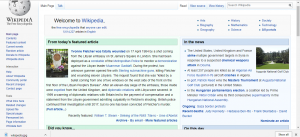I first heard of hypertext in the context of Wikipedia as a hypertext—it took me a while to understand the web itself as hypertext, which is maybe where I remain most confused—not all pages are interconnected, but I suppose they don’t have to be). But it makes sense to me in the context of Wikipedia—I’ve rarely read a whole Wikipedia article, but enjoy getting lost in the sea of links learning little, potentially inaccurate bits about a lot of things, or clicking a citation to an outside page.
Hypertext, as Vandendorpe says, makes the concepts of “page” and “text” be rethought. He says that reading was “previously shaped by the physicality of the codex” (210) but, with hypertext, is more fragmented. Pages are not physically bound into a manuscript that users understand they should read cover to cover; rather, they are fragments “whose meaning depends on the context” (210). Readers can easily shift from page to page—not reading from cover to cover, but following from page to page. This is a benefit because it gives freedom to the reader, who can switch to what interests them. Drawbacks are especially apparent as the “transition” time that Vandendorpe talks about goes on; there are different guidelines about how many characters per line and how a text should be displayed online. These different rules can make some texts hard to read. Hypertext also fragments linearity—when the reader is free to skim, pick, and change pages, they are less likely to read the full page.

Hypertext seems exclusive to digital writing—that’s where I think I’ve seen it most. But I have a question about print hypertext, which some others have mentioned—is such a thing possible? I think of texts like dictionaries or encyclopedias, which may refer readers/users to another part of the text—they are linked through suggestions for further reading. Vandendorpe says that “hypertext is a way of linking any portion of a document to another one” (209)—would it be possible to count encyclopedias, dictionaries, choose-your-own adventure books, etc. as types of hypertext?
Word Count: 347
Works Cited
Vandendorpe, Christian. “Reading On Screen: The New Media Sphere.” pp. 203–215.
